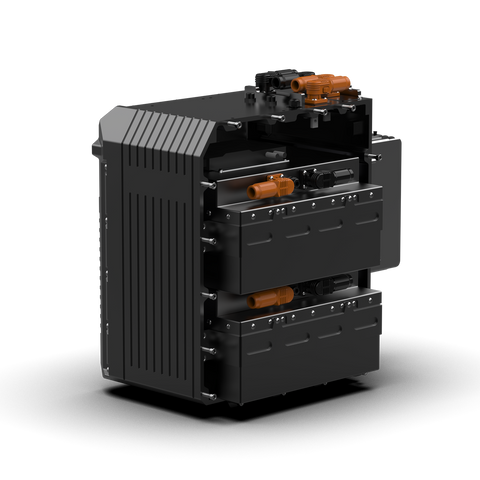In the early days of the electric vehicle wave, one of the biggest challenges facing the industry was ensuring the safety of the vehicle’s battery pack.
With traditional vehicles, gasoline burns in a slow, detectable way — you can often smell a leak or notice it before a fire starts. Gasoline fires typically need an ignition source like a spark or heat, and there are usually warning signs beforehand.
But lithium-ion battery fires are much more dangerous because they can be silent and sudden. When a battery cell overheats or shorts out, it can trigger a thermal runaway — a chain reaction that happens in seconds, with no smell, no warning smoke, and temperatures soaring past 600°C, potentially causing explosions or rapid fire spread across nearby cells.
Because of this inherent difference and the difficulty in controlling such reactions, the EV industry was forced to develop multi-layer defense systems — technologies designed to catch issues early, isolate them, and protect users before they even notice something is wrong.
That said, it’s important to look at the full picture: Recent research and statistics show that EVs are still safer overall than gasoline vehicles.
A study by AutoInsuranceEZ, based on U.S. National Highway Traffic Safety Administration (NHTSA) data, shows:
-
Gas-powered cars catch fire at a rate of 1,530 fires per 100,000 vehicles sold
-
For EVs, the number drops to just 25 fires per 100,000 vehicles
In other words, gas cars are over 60 times more likely to catch fire than EVs — largely thanks to the rapid advancement in EV battery safety technologies, especially the now-industry-standard 5-layer protection model.
🔍 The Origin of the 5-Layer Protection Standard
Several major automakers like Tesla, Chevrolet, and Chinese manufacturers have dealt with serious battery fire incidents, mostly caused by:
-
Internal short circuits after hard impacts
-
Overheating during fast charging or unstable power input
-
Defective cells that weren’t detected in time
One of the most well-known cases was in 2020, when thousands of Chevrolet Bolt EVs were recalled due to spontaneous fires caused by faulty cells shorting internally — even while the car was parked.
Or in 2013, a Tesla Model S exploded after hitting a piece of metal on the highway that pierced the battery pack underneath — prompting the entire industry to rethink battery design and protection.
The 5-layer standard didn’t come from a formal regulation — it emerged from real-world experience and painful lessons learned as EVs became mainstream.
At its core, this method is not just about preventing fires — but about detecting potential risks early, isolating them effectively, and keeping the entire system safe under all conditions.
⚙️ How N1-S's 5-Layer Battery Protection Works
1️⃣ THERMAL PROTECTION
Real-world scenario:
You’re riding the N1-S under the blazing summer sun, cruising at 60–70 km/h for 30 minutes straight. Even with the extreme heat, thermal control systems prevent the battery from overheating — reducing risk of thermal damage or degradation.

How it works:
Inside the battery pack, high-temperature-resistant materials and heat-dissipation layers surround each cell. The outer casing is made of high-conductivity aluminum, with built-in cooling vents to help quickly release internal heat.
When internal temps rise past safe thresholds (typically 50°C), the system uses both passive cooling (like natural airflow) and active control via battery management software to reduce charge/discharge rates and stabilize temperature.
The aluminum casing combined with thermal pathways ensures heat is dispersed quickly — even during high-performance use.
2️⃣ MECHANICAL PROTECTION
Real-world scenario:
You hit a rough patch of road or slam into a deep pothole. On most bikes, such impact could snap wires or dent the battery casing. On the N1-S, however, the mechanical armor protects the battery from structural damage. Even if the bike tips over in a parking lot, the impact doesn’t compromise the system.
✅ Cách thức hoạt động:
The battery casing is made from solid die-cast aluminum alloy — lightweight but tough, with structural ribs inside to absorb impact. The surface is anodized to prevent corrosion and withstand humidity and dust.


Sealed with industrial-grade rubber gaskets and adhesives, the battery meets IP67 water and dust resistance standards:
-
IP6x: Completely dustproof
-
IPx7: Can survive submersion in 1 meter of water for 30 minutes
What makes the N1-S unique is its dual-layer protection:
-
Inner pack encased in water-sealed steel for full cell protection
-
Outer casing made from aerospace-grade aluminum for heat dissipation and extra impact resistance
-
Plus, the battery pack is mounted high above the ground (around 50cm), making it resistant to flooding and deep puddles.

3️⃣ ELECTRICAL PROTECTION
Real-world scenario:
Some EVs on the market overheat, leak current, or short out — often due to poor-quality components or improper engineering. With the N1-S, every part of the electrical system, especially the battery, is engineered to the highest safety standards — from connectors and BMS to busbars, cells, and the charging unit.

How it works:
Cables and connectors are made from materials designed for high current flow without overheating. For example, connectors use multi-layer insulation like TPE or XLPE — advanced materials also used in automotive and aerospace industries — ensuring heat resistance above 100°C and long-term durability in humid environments.
Instead of loose plugs, all connections in the N1-S are sealed and tightly clamped, preventing:
-
Moisture or dust from reaching circuits
-
Sparking from loose or unstable contact points
Critical junctions are reinforced with heat-shrink tubing for extra insulation and reliability.
Even when using weak or unstable power sources, the N1-S charging unit regulates input voltage and current within safe limits. A built-in temperature sensor cuts off charging if the system gets too hot — stopping risks before they start.
4️⃣ ELECTRONIC & SOFTWARE PROTECTION
Real-world scenario:
Let’s say one cell starts to degrade — losing voltage faster than normal. You won’t hear any alarms, see any warning lights. But behind the scenes, the Battery Management System (BMS) is already rebalancing the pack — adjusting charge and discharge to keep everything running smoothly.
How it works:
The BMS monitors every aspect of the battery — voltage, current, and temperature — down to individual cells, 24/7. Even the slightest irregularity is detected and corrected automatically to maintain safety and performance.

It doesn’t just respond to problems — it proactively maintains the battery by balancing cell performance, preventing overheating, and adjusting discharge levels based on real-time conditions.
Any significant anomaly is instantly reported to the user app and logged for technicians — enabling remote diagnosticsor quick maintenance at the shop.
5️⃣ SENSOR PROTECTION
Real-world scenario:
You’re riding up the steep Bảo Lộc Pass. The bike is under heavy load, and the battery starts warming up. Just like software protection, the sensor system picks this up instantly and reduces output to cool things down — without you even noticing a thing.
How it works:
The N1-S battery pack is equipped with strategically placed thermal sensors that monitor sensitive zones — near cells, heat sinks, and critical connectors.
There are also current and voltage sensors that constantly track flow during both charging and discharging. These readings are updated multiple times per second, giving the control system a real-time snapshot of battery health.
When something’s off, the sensor system and BMS work together to instantly adjust operation or notify the user, ensuring maximum safety at all times.

✅ In Summary
When you look at an electric motorbike, it’s easy to be drawn to its speed, sleek performance, and futuristic design. But beneath that smooth ride is an intricate system working silently — not just to power the bike, but to protect you every step of the way.
Peace of mind and durability are just as important as speed and style when it comes to a great machine. The N1-S isn’t just a high-performance electric motorbike with eye-catching design — it’s a smart, silent guardian that keeps you safe… even before you realize there’s something to worry about.



